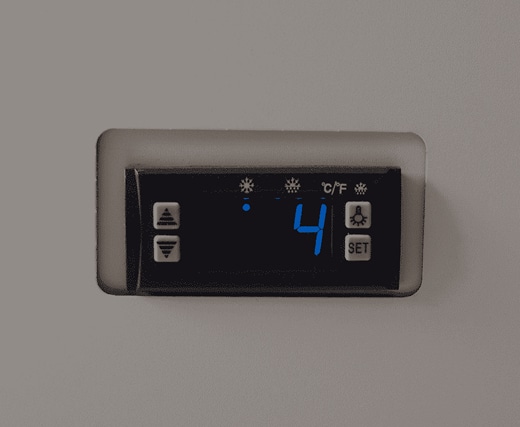Ice Machine Use Cases: Does Your Business Need an Ice Machine?
In general, the role of a commercial ice machine is to make relatively large amounts of ice. While “makes ice” is universal, many other things aren’t. The amount of ice produced, the style of ice, the storage methods, the unit’s size and installation, vary from machine to machine.
Understanding the use cases of the various types of ice makers will help you decide whether you need a commercial ice machine, and which would best fit your needs.
What is the role of an ice machine?
The role of an ice machine is to make ice. Ice machines do this by moving water through coils where a condenser cools it below freezing. This process can produce several types of ice, such as cubes, flakes, or nuggets, depending on the unit.
If your business relies on a steady supply of ice, whether it’s for serving drinks in a restaurant, bar, cafe, or hotel, or for keeping food chilled while on display or in transit, you can benefit from an ice machine.
What are the different types of ice machines?
Understanding the types of ice available and the best use of each will help you pin down which ice maker suits your business. There are typically five types of ice produced by a given machine. They are:
- Solid cube
- Hollow ice
- Flake ice
- Half-dice ice
- Nugget ice
Slow melting options, such as solid ice cubes and hollow cubes, are great for cocktails and general drinks where maintaining a cold temperature is crucial. The surface area and size of solid and hollow cubes means they melt relatively slowly. This allows them to keep drinks colder longer without diluting them.
On the other hand, fast-melting options like flake, half-dice, and nugget ice are well-suited for specific needs. Flake ice is easily blended and perfect for frozen drinks. However, it can create a slushy appearance in regular drinks.
Half-dice ice offers a good balance, being easier to blend than full-size cubes while maintaining a clear appearance. Finally, nugget ice, known for its chewiness and flavour absorption, is particularly popular in fast food chains and situations where customers may enjoy eating the ice.
Location Type
Ice machines come in different shapes and sizes to accommodate different locations.
- Undercounter ice machines are compact and fit under counters or bars. They are good options for areas with limited space or low ice needs, like small restaurants, cafes, or convenience stores.
- Self-contained ice machines have ice production and storage bins in a single unit. They often have lower upfront costs, easy installation, and don’t take up much space. They can produce medium-to-high yields and are suitable for various businesses. However, they don’t scale well compared to other options.
- Modular ice machines have two separate pieces: a head (that makes ice) and a bin that stores it. This allows for scalability, letting you expand your ice production capacity as needed. This makes them strong options for large-scale operations like hotels and food service companies.
- Remote ice machines provide increased flexibility for larger or more complex needs where location is an issue. The ice production unit is separate from the ice dispenser, allowing ice to be dispensed at different locations within the establishment. This is beneficial for multi-level buildings or areas tight on space.
Condenser Type
Ice makers work by using a refrigerant to remove heat from water so it can freeze. This heat needs to be dissipated, and that’s what the condenser does. The type of condenser a unit uses can affect efficiency, consistency, operating costs, and space demands.
There are three main types:
- Air-cooled condensers use fans to draw ambient air over the coils. They are cost-effective but less efficient in hot climates and can be noisy.
- Water-cooled condensers use water to cool the refrigerant, offering high efficiency, low noise, and reduced heat release. However, they require plumbing connections and can consume more water.
- Remote condensers are separate from the ice machine, allowing for quieter operation, improved indoor air quality, and flexible placement. They can be air-cooled or water-cooled.
How can you use ice machines in your business?
When it comes to running a business, ice has several applications. Serving beverages will be a primary application in many settings. For other businesses, applications include preserving food and avoiding spoilage, keeping products cold in transport, or displaying food, which must be kept on ice.
Beyond food, the medical field requires ice for various purposes related to patient care and comfort. Below, we’ll cover each application in more detail to help you choose the perfect ice machine. For more information, check out our in-depth guide to types of commercial ice machines.
Making and serving beverages
Nearly every hospitality venue will benefit from an ice machine for serving drinks. For example, hotels and resorts may need ice for guests’ rooms, cafeteria areas, and kitchens. While smaller businesses like cafes may use ice for juices, smoothies, or iced coffees.
From big businesses to family-run establishments, if you serve drinks that customers want cold, you’ll need ice. The exact size of machine will depend on how much ice your business uses in a day.
Self-contained machines can be a good option for smaller establishments with lower ice demands. A free-standing or modular machine would best serve larger businesses with higher needs.
Depending on the beverages you serve, you’ll also want to consider which ice type is best.
Food preservation and safety
Ice machines are incredibly valuable for keeping meat and produce fresh. Using ice to pack perishable items helps cool them quickly, slows the growth of bacteria, and extends product shelf life.
Ice machines also play a key role for businesses that display food items, like seafood. This is common for delis, supermarket seafood markets, and restaurants with raw bars for oysters and clams. The proper use of ice in these situations not only maintains the freshness and quality of your food but also enhances the customer experience by showcasing appealing products.
Food transportation
Ice is a must-have for many businesses transporting perishable food or pharmaceuticals. By packing and transporting in ice, you can reduce temperature fluctuations, which can spoil more delicate products.
Furthermore, ice is a reliable method of transportation for a wide range of goods. As such, meat or produce distributors, catering companies, and pharmaceutical companies can all use ice machines for food transportation.
Food preparation
Beyond cooling beverages, ice has several other benefits for many types of business. For example, restaurants often need to quickly cool hot sauces or soups to be served or stored right after they are made.
An ice machine can significantly increase output in bakeries, where a steady supply of ice can rapidly cool dough, shorten mixing times, and improve consistency. The same is true for chilled desserts (ice creams, sorbets, etc.), where elements are best served cold.
Food presentation
Commercial ice machines are valuable to businesses like delis, caterers, and buffets where food presentation is key. Of course, there is overlap here with safety, as food must remain cold to stay fresh while on display.
In larger settings like a seafood market, or buffet, ice beds keep food chilled while showcasing it to patrons and customers in a convenient manner. In other settings, ice may be used to garnish a single dish. For example, Japanese sashimi is typically served on a platter or on ice with some sort of garnish.
Medical uses
Ice machines are extremely valuable to the medical field. In patient care, ice is essential for pain management and reducing fever, inflammation, and swelling. Ice also provides convenient and comfortable hydration for patients who may have difficulty drinking. An ice machine that produces an adequate supply of ice and is reliable and convenient will be of the utmost importance in many medical and healthcare settings.
In addition, hospitals will need to serve drinks to staff and patients. In many cases, this also necessitates the use of an ice machine.
How to choose the right ice machine for your needs
With an idea of the various types of ice machines available and the typical use cases, here are the factors you should consider when finding the ideal ice machine for you.
Specific Needs
Different industries have different ice requirements. Ask yourself how much ice you use in a 24-hour period to gauge what size unit you may need. If your demand isn’t high, you may consider smaller units. If you’re likely to increase your need in the future, keep that in mind, as not all units scale well.
Ice Type
Once you know how much ice you need, you’ll need to determine which type of ice best fits your needs. Restaurants may prioritise the production of solid cubes, while a smoothie bar may need easier-to-blend ice. Carefully examine what purpose you want your ice to serve and choose accordingly.
Location and Space
Consider your available space and assess where you can accommodate a unit that provides easy access for staff and allows for proper ventilation, drainage and other requirements.
Browse Bromic commercial ice machines
Knowing the different types of commercial ice machines available and their case uses, you can make a more informed decision on which unit is best for you. Browse Bromic commercial ice machines and find the perfect product for your needs.








